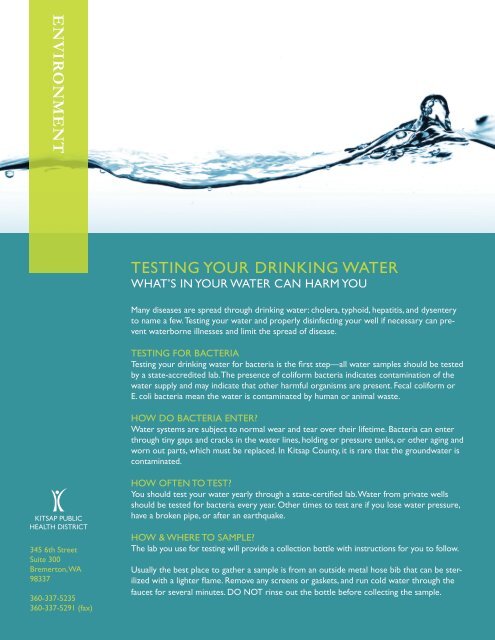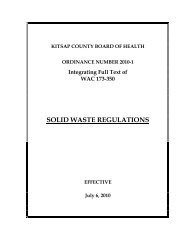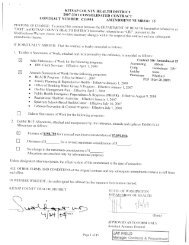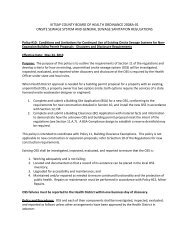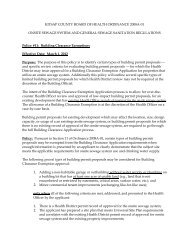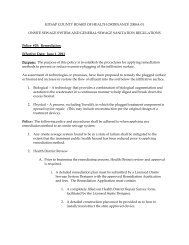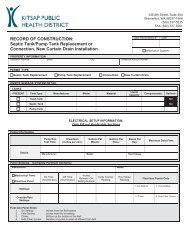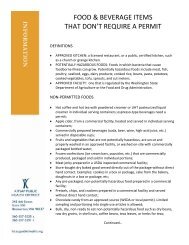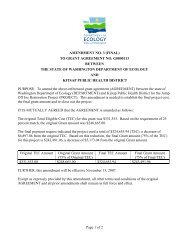Testing your water - Kitsap Public Health District
Testing your water - Kitsap Public Health District
Testing your water - Kitsap Public Health District
Create successful ePaper yourself
Turn your PDF publications into a flip-book with our unique Google optimized e-Paper software.
ENVIRONMENT<br />
TESTING YOUR DRINKING WATER<br />
WHAT’S IN YOUR WATER CAN HARM YOU<br />
Many diseases are spread through drinking <strong>water</strong>: cholera, typhoid, hepatitis, and dysentery<br />
to name a few. <strong>Testing</strong> <strong>your</strong> <strong>water</strong> and properly disinfecting <strong>your</strong> well if necessary can prevent<br />
<strong>water</strong>borne illnesses and limit the spread of disease.<br />
TESTING FOR BACTERIA<br />
<strong>Testing</strong> <strong>your</strong> drinking <strong>water</strong> for bacteria is the first step—all <strong>water</strong> samples should be tested<br />
by a state-accredited lab. The presence of coliform bacteria indicates contamination of the<br />
<strong>water</strong> supply and may indicate that other harmful organisms are present. Fecal coliform or<br />
E. coli bacteria mean the <strong>water</strong> is contaminated by human or animal waste.<br />
HOW DO BACTERIA ENTER?<br />
Water systems are subject to normal wear and tear over their lifetime. Bacteria can enter<br />
through tiny gaps and cracks in the <strong>water</strong> lines, holding or pressure tanks, or other aging and<br />
worn out parts, which must be replaced. In <strong>Kitsap</strong> County, it is rare that the ground<strong>water</strong> is<br />
contaminated.<br />
KITSAP PUBLIC<br />
HEALTH DISTRICT<br />
345 6th Street<br />
Suite 300<br />
Bremerton, WA<br />
98337<br />
360-337-5235<br />
360-337-5291 (fax)<br />
HOW OFTEN TO TEST?<br />
You should test <strong>your</strong> <strong>water</strong> yearly through a state-certified lab. Water from private wells<br />
should be tested for bacteria every year. Other times to test are if you lose <strong>water</strong> pressure,<br />
have a broken pipe, or after an earthquake.<br />
HOW & WHERE TO SAMPLE?<br />
The lab you use for testing will provide a collection bottle with instructions for you to follow.<br />
Usually the best place to gather a sample is from an outside metal hose bib that can be sterilized<br />
with a lighter flame. Remove any screens or gaskets, and run cold <strong>water</strong> through the<br />
faucet for several minutes. DO NOT rinse out the bottle before collecting the sample.
WHAT IF MY WELL HAS COLIFORM BACTERIA?<br />
A repeat sample should be collected as soon as possible to verify the problem. If the new<br />
sample has bacteria, proceed as follows, based on <strong>your</strong> <strong>water</strong> source:<br />
HAND-DUG WELLS. These almost always are positive for coliform bacteria. The usual solution<br />
is to have a disinfection system installed or rely on another <strong>water</strong> source. Because <strong>water</strong><br />
treatment systems vary in cost, you’ll want to get more than one estimate. It may be necessary<br />
to submit an engineered design to us for approval.<br />
DRILLED WELLS. Contamination can occur in many places, from openings in the top to aging<br />
parts and equipment to a failed pressure tank bladder. If an inspection reveals that <strong>your</strong> system<br />
is sound, you’ll want to disinfect the well and <strong>water</strong> distribution system.<br />
WHAT IF MY SAMPLE HAS FECAL BACTERIA?<br />
In this case you must boil <strong>your</strong> drinking <strong>water</strong> or use bottled <strong>water</strong> until the problem is corrected.<br />
Collect a repeat sample as soon as possible to verify the results. If ANY bacteria are<br />
present, you must inspect and disinfect the <strong>water</strong> source and system.<br />
DISINFECTING A WELL AND WATER SYSTEM<br />
These instructions apply to dug and drilled wells:<br />
1. Start with a new gallon of liquid chlorine bleach (5% sodium hypochlorite) with NO<br />
additives.<br />
2. Remove the well casing cover.<br />
3. Add one-half gallon of liquid bleach to the well.<br />
4. Connect a hose to the faucet nearest the well. If this isn’t possible, proceed to step<br />
No. 6.<br />
5. Turn on an outside faucet and run the <strong>water</strong> on the ground until you can smell the<br />
bleach. Use the hose to wash down the inner wall of the well, protecting <strong>your</strong> eyes and<br />
clothing. When finished, turn off the faucet, remove the hose, and close up the well.<br />
6. Turn on an outside house faucet and run it until you smell chlorine; then turn it off.<br />
7. Repeat step No. 6 with all outside and inside faucets. Moving the chlorinated <strong>water</strong><br />
through the system completes the disinfecting.<br />
8. Let the chlorine remain in the pipes overnight. If possible, don’t use any <strong>water</strong> during<br />
this time.<br />
9. The next day, using outside faucets, flush as much <strong>water</strong> through the system as possible.<br />
It’s best to connect a hose, allowing the <strong>water</strong> to seep into the ground. Keep <strong>water</strong><br />
going into <strong>your</strong> septic system to a minimum.<br />
10. Be sure to flush showers before use, and refrain from washing colored clothes for a<br />
day or two.<br />
11. Expect <strong>your</strong> <strong>water</strong> to be cloudy for one or two days. It will take about five days before<br />
the chlorine smell is completely gone.<br />
12. Chlorine must be completely flushed from the system before collecting samples for<br />
repeat bacteria testing. You can retest with a chlorine test kit, available at pool or spa<br />
supply stores.<br />
QUESTIONS?<br />
Call us at 360-337-5235.<br />
kitsappublichealth.org


